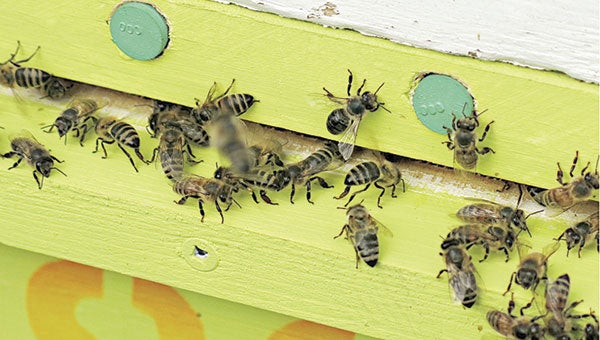Bees feel the squeeze as cropland consumes habitat
Published 10:07 am Tuesday, September 1, 2015

Honeybees entered a hive through a pollen trap designed to collect pollen the bees are carrying. Scientists then analyze the pollen to see which plants the bees are using and assess the nutritional value of the pollen on Aug. 6 near Jamestown, North Dakota. Dan Gunderson/MPR News
By Dan Gunderson
MPR.org/90.1 FM
JAMESTOWN, N.D. — Corn and soybeans may be good for cattle and humans — but not bees.
The insects prefer plants with lots of pollen and nectar, and in this part of the country it’s become increasingly difficult for them to find what they need to stay healthy.
Good times in agriculture have led farmers to roll land out of conservation programs and into crops. It’s a shifting landscape that can be seen across eastern North Dakota and western Minnesota, and bees are paying the price.
“The bees are potentially being squeezed out of some of those areas that are being converted from pasture or fallow land or hay land to row crops,” said Matthew Smart, a researcher with the U.S. Geological Survey.
Smart and USGS research ecologist Clint Otto are in the middle of a three-year project to learn how bee health is connected to land use in the Midwest, where nearly two-thirds of U.S. commercial beekeepers spend at least part of the year. They’re studying bees living on tracts planted with native, bee-friendly plants and comparing them to those living largely among crops.
The work is a vital part of the effort to restore the health of the nation’s bee population, which has become an increasing worry.
Bees pollinate plants that grow many of the nation’s fruits and vegetables. A national survey last spring estimated honeybee deaths in the U.S. at 40 percent for the past year with Minnesota beekeepers reporting more than 50 percent losses. Disease, pesticides and poor nutrition are all possible culprits.
Smart and Otto are studying 30 “bee yards” in North Dakota, Minnesota and South Dakota to see if pollinator conservation efforts led by the United States Department of Agriculture are working.
That includes a strip of land near Jamestown, where on a recent day a few honey bees and native bees zipped from flower to flower.
“We go out and quantify what flowers are available to the bees,” Otto said as he walked the field. “Then we can go back to the actual bee colony and collect pollen to see if the bees are actually targeting plant species that are included in this particular USDA conservation seed mix.”
Some of the bee yards — where dozens of hives are stacked in a square roughly 30 feet by 30 feet — are in areas of diverse habitat. Others are near mostly corn and soybean fields.
Smart fired up his smoker used to calm bees and we suit up to look at the nearby bee colonies. About 1.8 million bees live in this apiary. Researchers use sensitive scales to track the weight of hives. On a really good day, bees can collect 10 pounds of nectar.



